Assessing the competitive advantages of tourism potentials in Tuy Hoa city, Phu Yen province
ABSTRACT
This paper presents a Quantified SWOT (Strengths, Weaknesses, Opportunities
and Threats) analytical method and an analytical hierarchy process method
which provides more detailed and quantified information on tourism potential in
Tuy Hoa city. Quantified SWOT analysis was used to assess the competing
strength of Tuy Hoa’s tourism potential with other places. The results of the study
presented that Tuy Hoa city has many advantages of beautiful natural landscapes,
nature, rivers and mountains. The results of the comparing value of internal and
external factors of Tuy Hoa’s tourism potential indicated it under high
competitive pressure from neighbor destinations such as Phan Thiet, Hue, Nha
Trang and Da Nang. Tuy Hoa’s tourism potential was lower than that of neighbor
cities but it has more attractive tourism features.
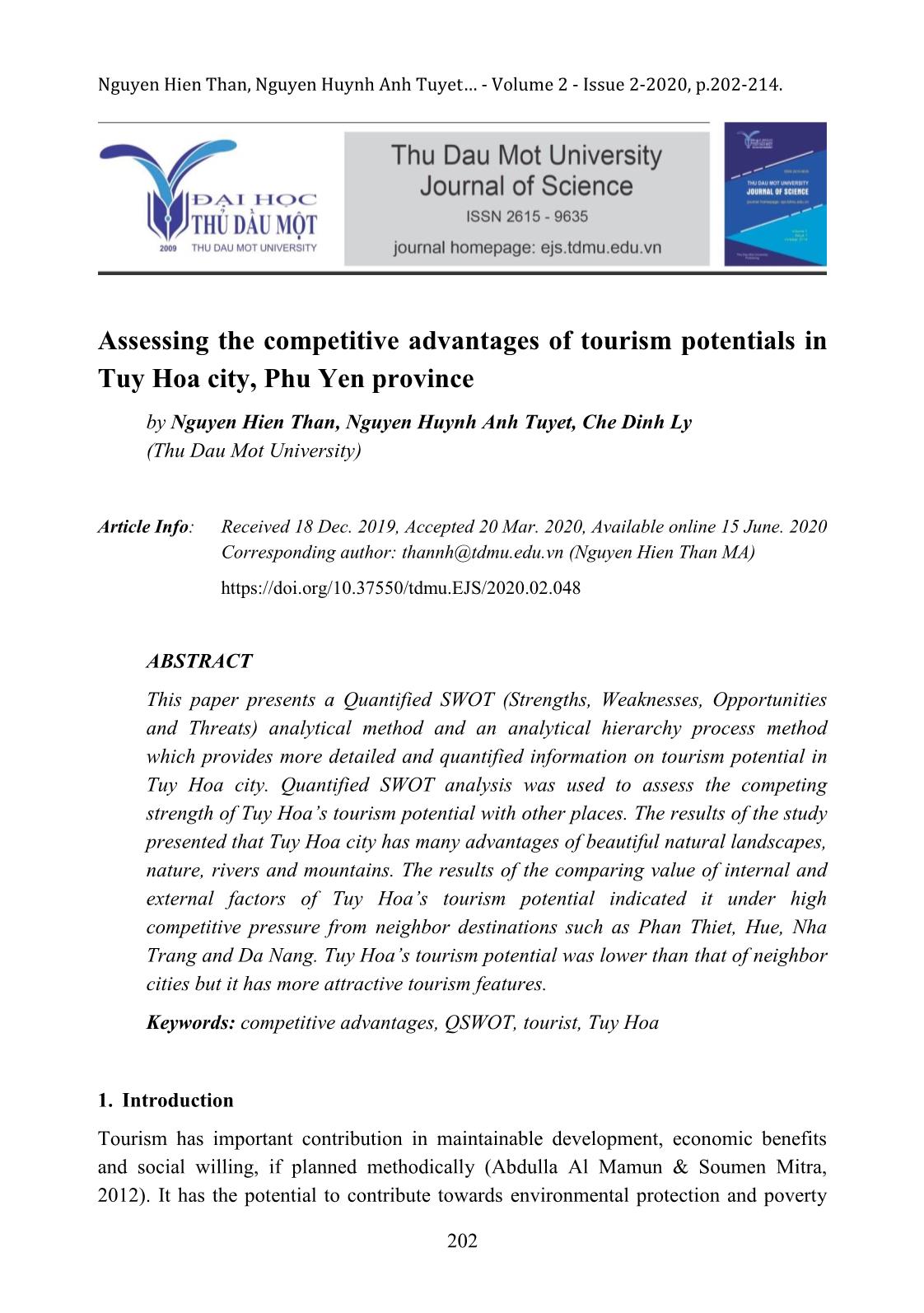
Trang 1
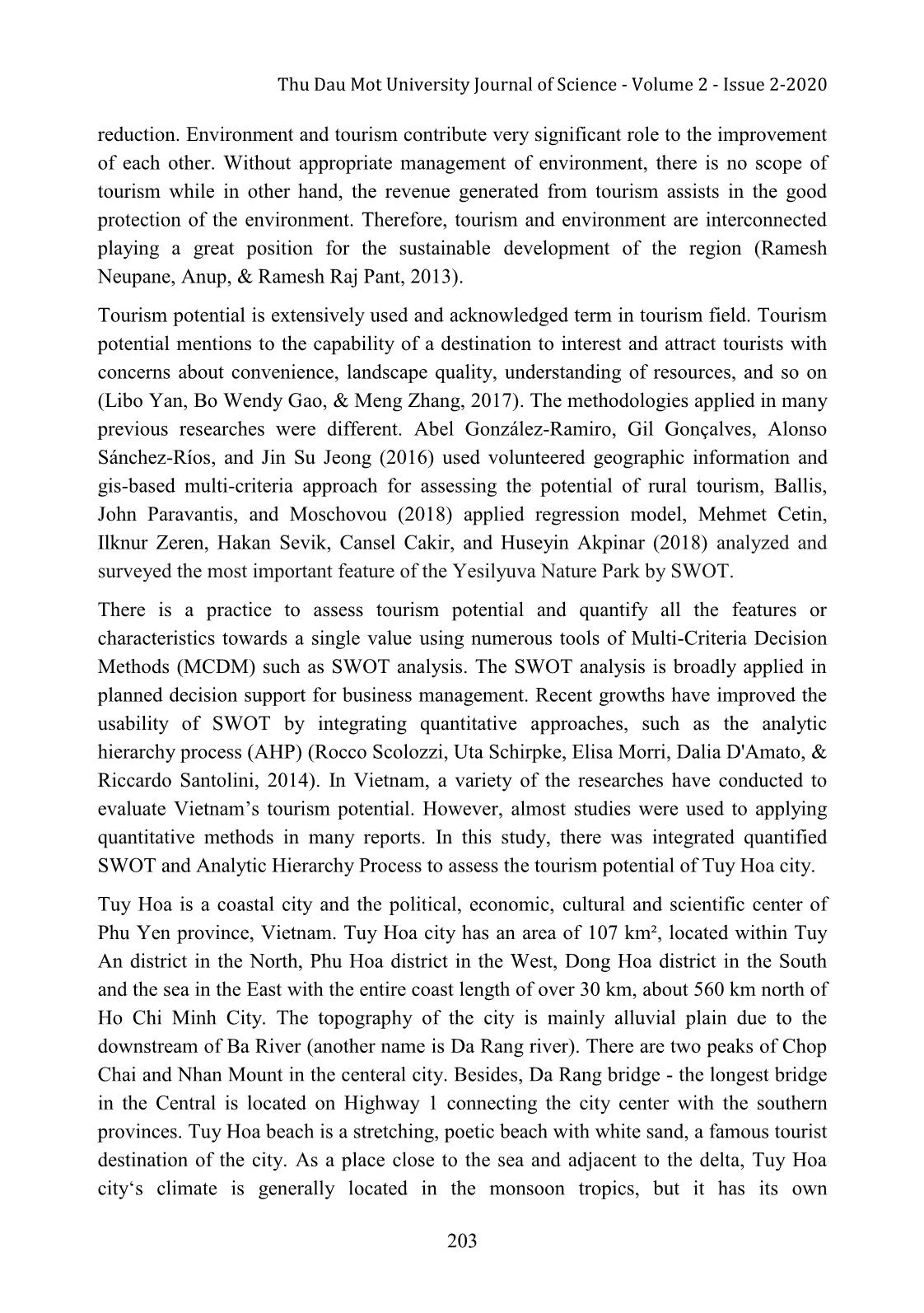
Trang 2
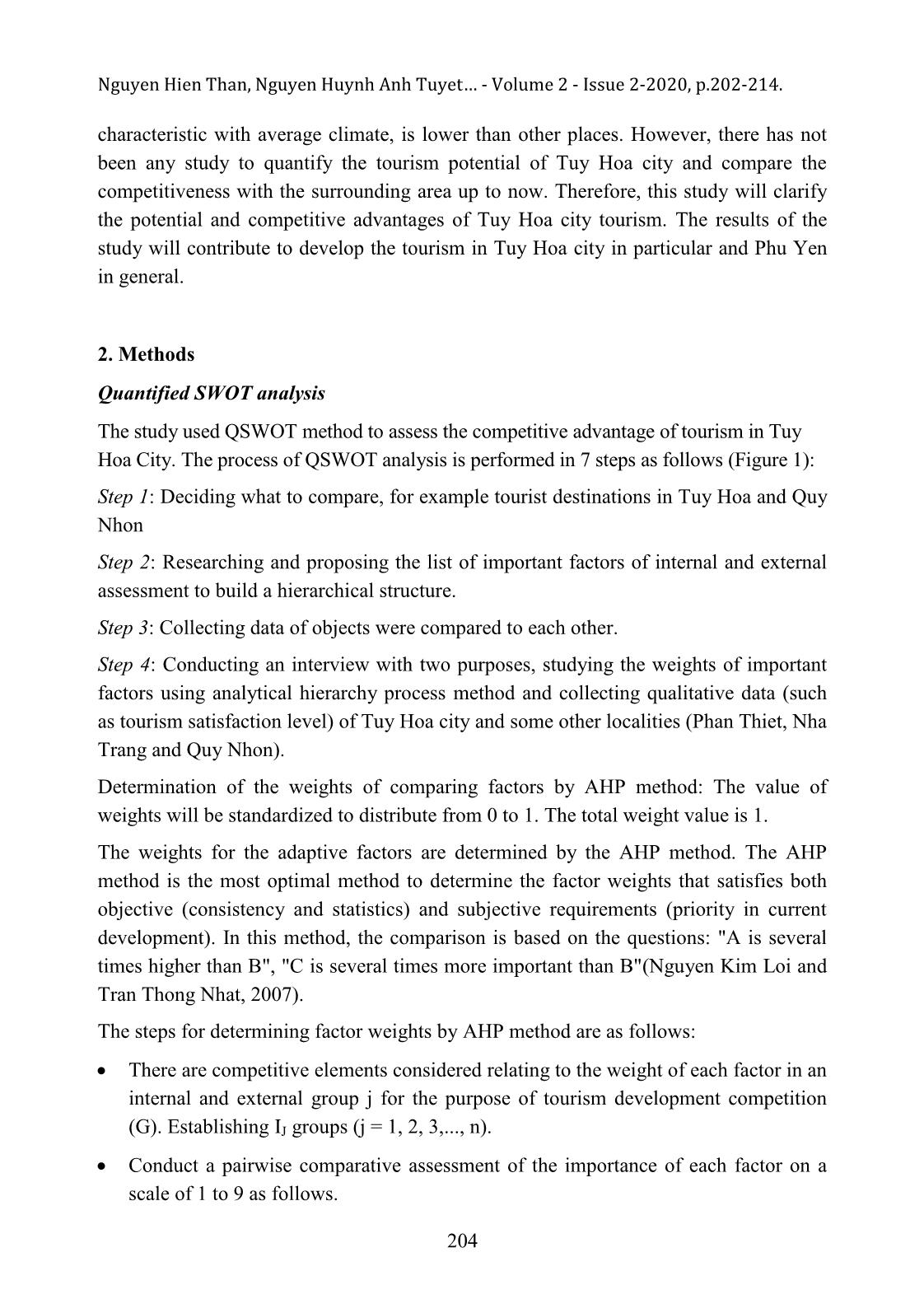
Trang 3
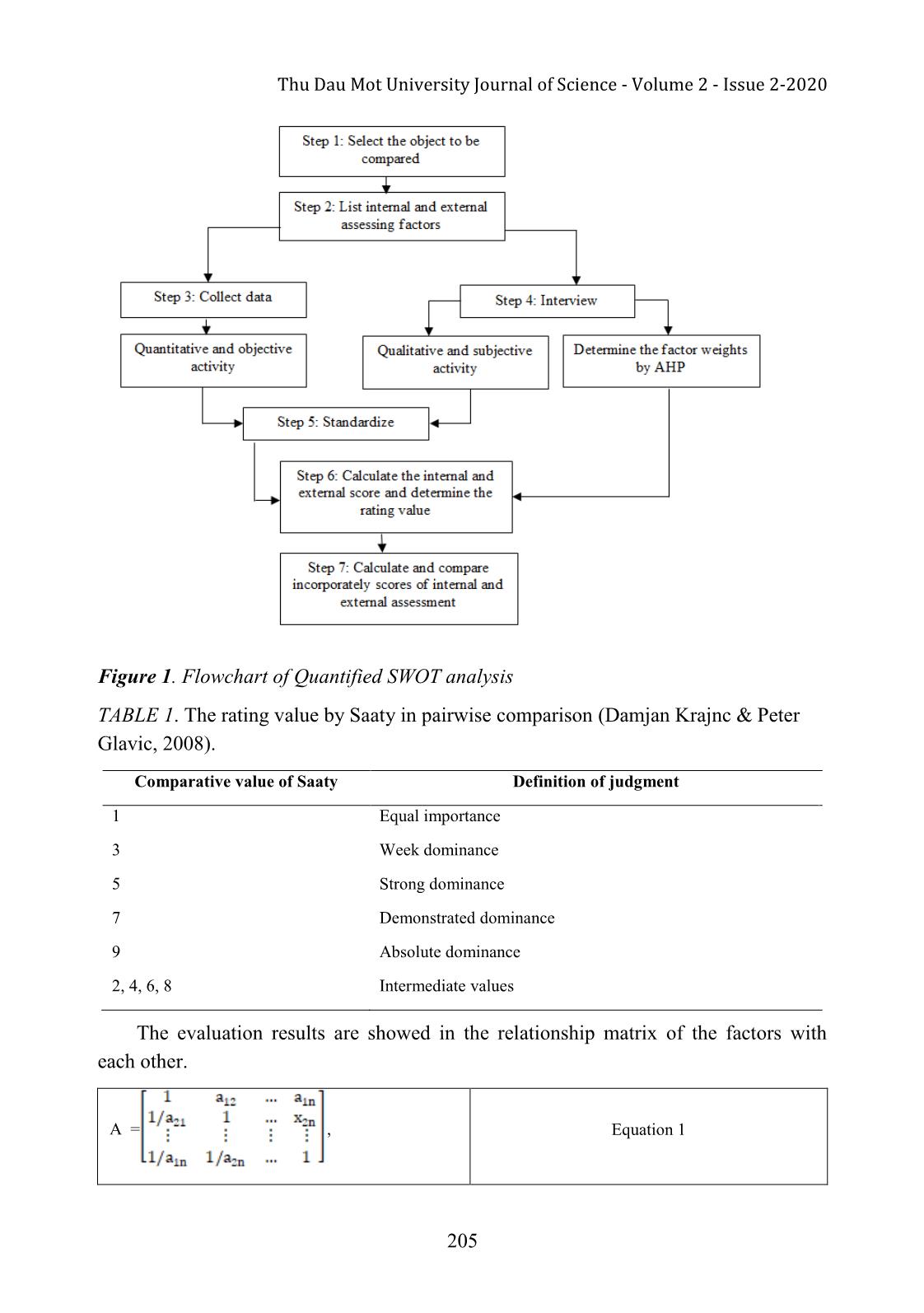
Trang 4
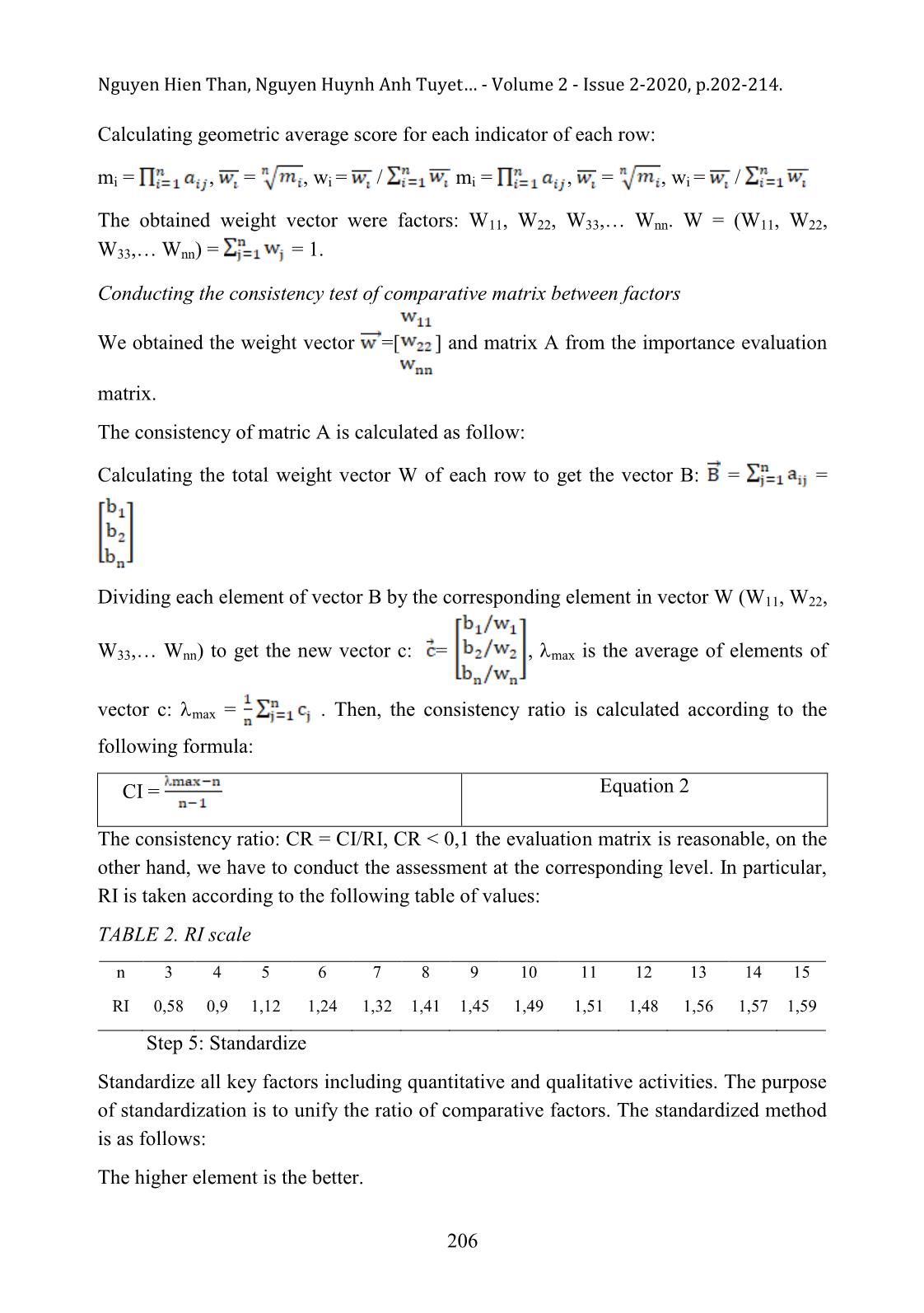
Trang 5
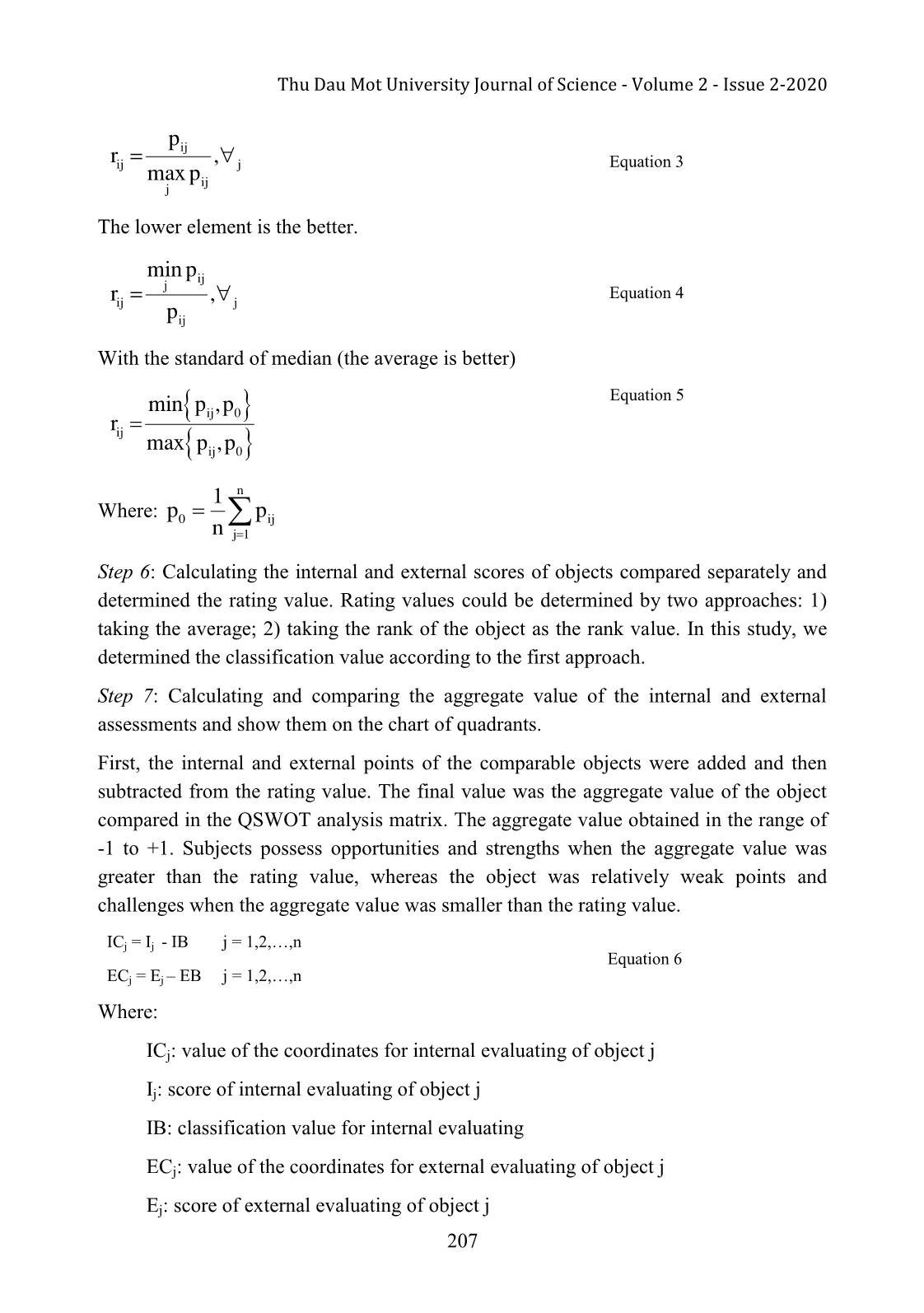
Trang 6
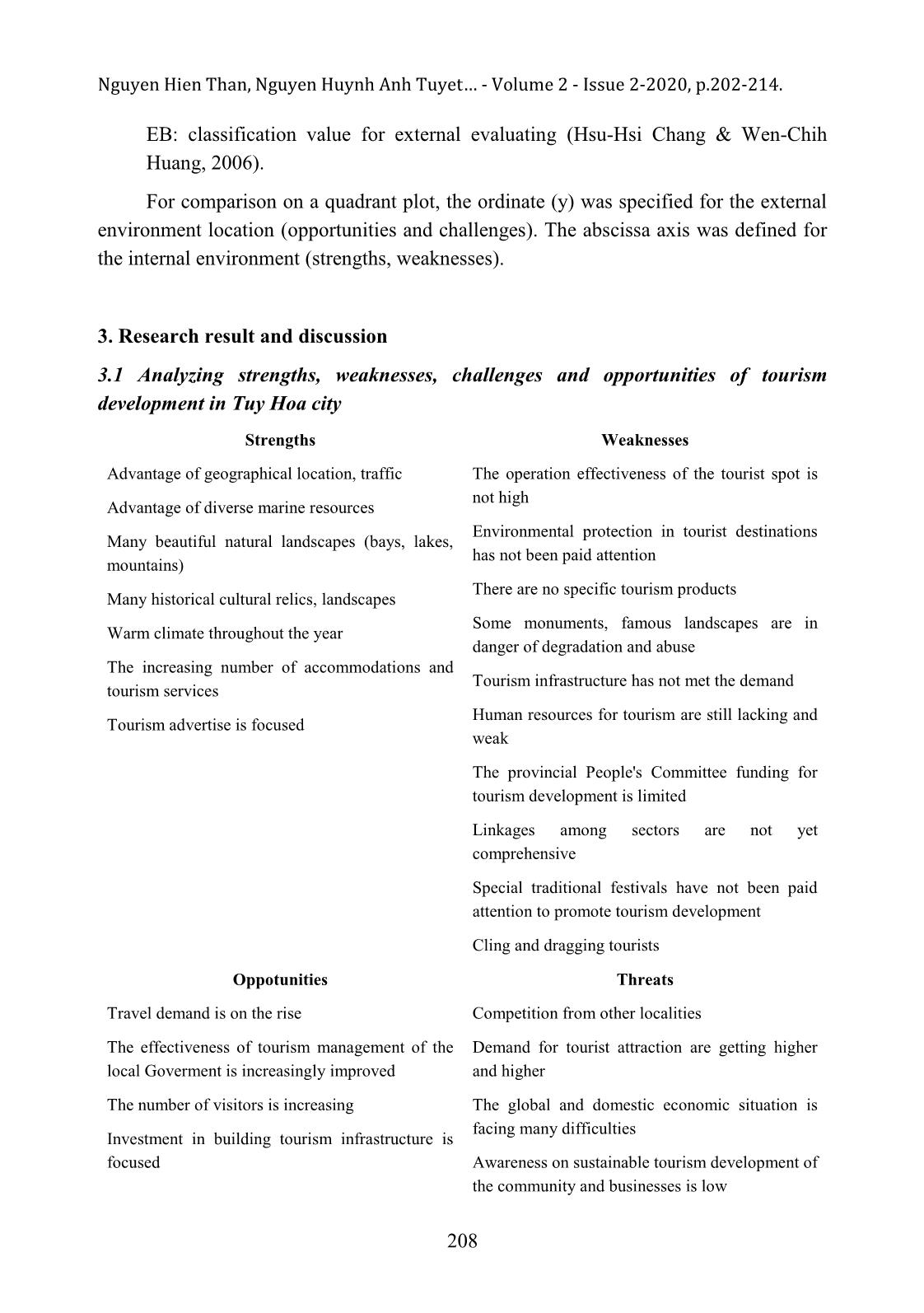
Trang 7
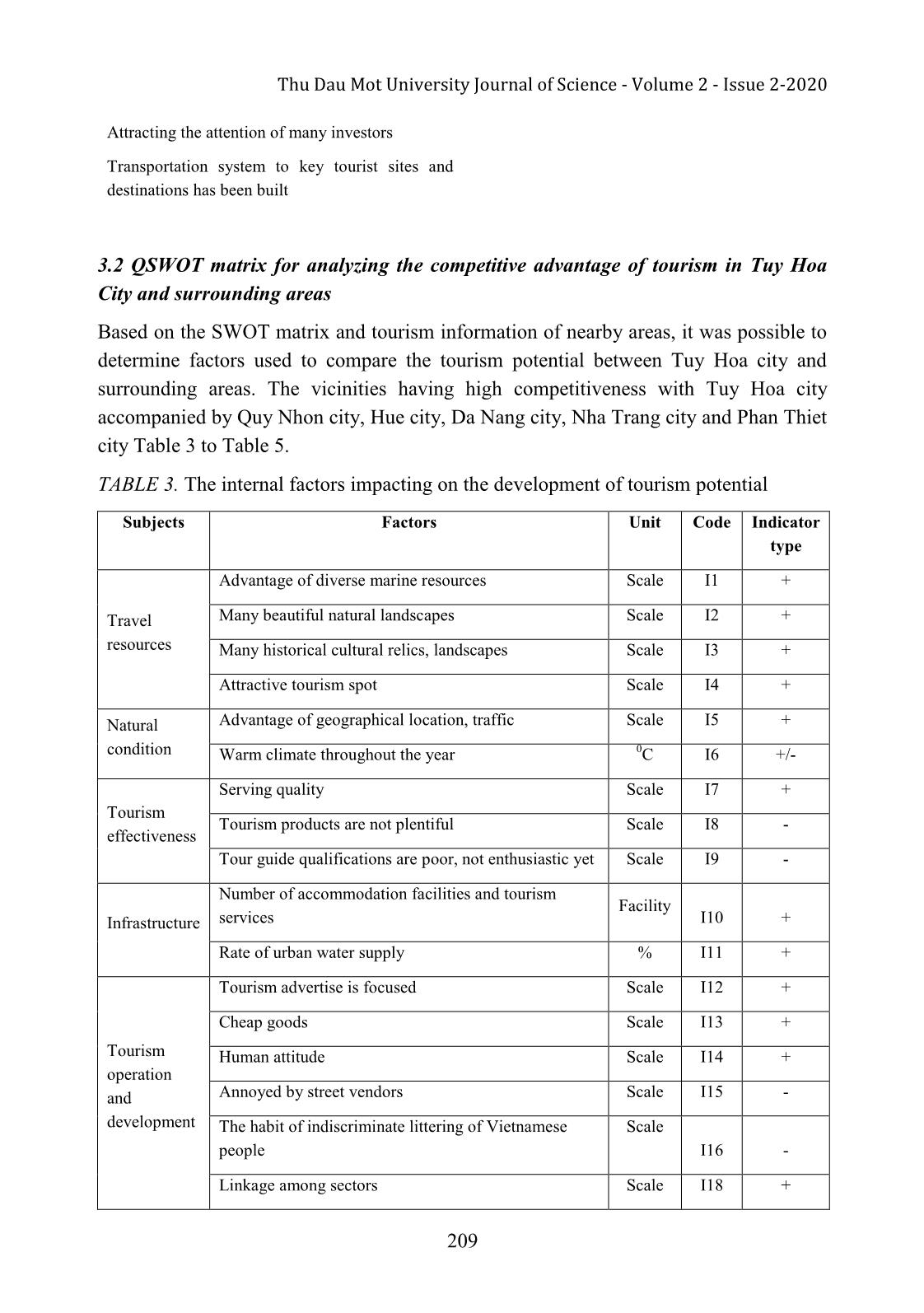
Trang 8
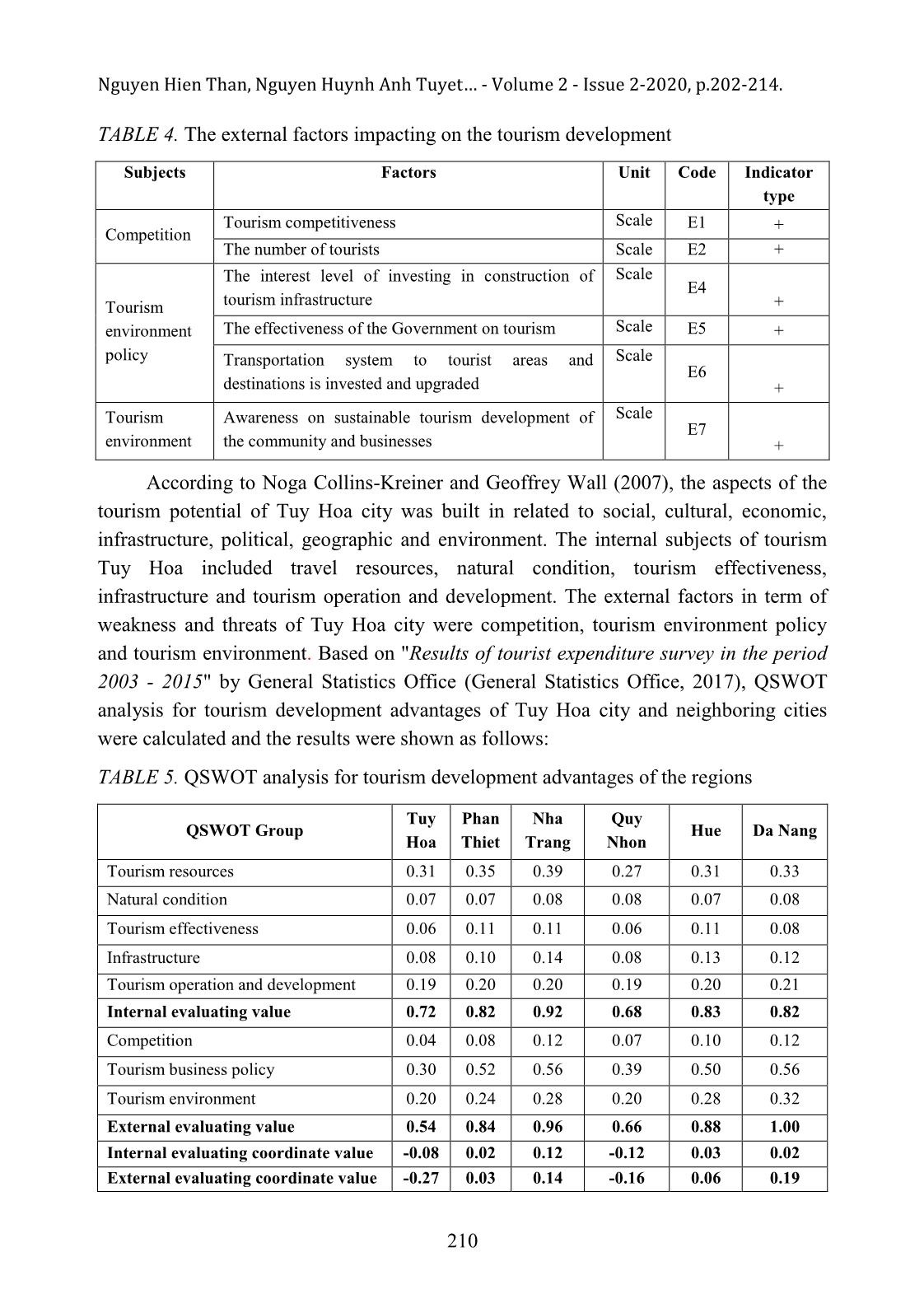
Trang 9
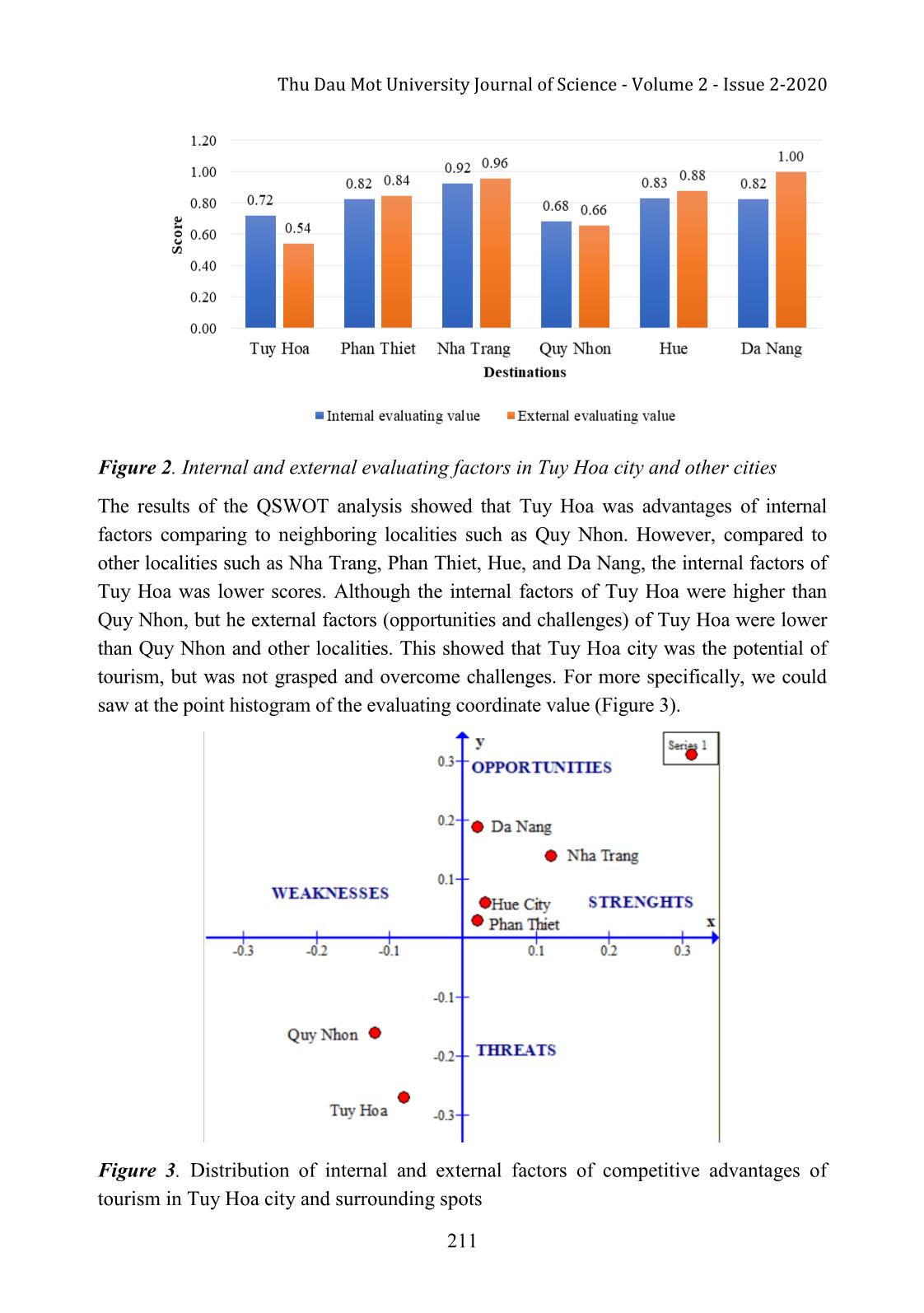
Trang 10
Tải về để xem bản đầy đủ
Tóm tắt nội dung tài liệu: Assessing the competitive advantages of tourism potentials in Tuy Hoa city, Phu Yen province
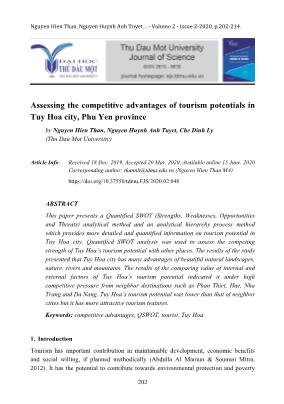
f Science - Volume 2 - Issue 2-2020 207 ij ij j ij j p r , maxp Equation 3 The lower element is the better. ij j ij j ij min p r , p Equation 4 With the standard of median (the average is better) ij 0 ij ij 0 min p ,p r max p ,p Equation 5 Where: n 0 ij j 1 1 p p n Step 6: Calculating the internal and external scores of objects compared separately and determined the rating value. Rating values could be determined by two approaches: 1) taking the average; 2) taking the rank of the object as the rank value. In this study, we determined the classification value according to the first approach. Step 7: Calculating and comparing the aggregate value of the internal and external assessments and show them on the chart of quadrants. First, the internal and external points of the comparable objects were added and then subtracted from the rating value. The final value was the aggregate value of the object compared in the QSWOT analysis matrix. The aggregate value obtained in the range of -1 to +1. Subjects possess opportunities and strengths when the aggregate value was greater than the rating value, whereas the object was relatively weak points and challenges when the aggregate value was smaller than the rating value. ICj = Ij - IB j = 1,2,,n ECj = Ej – EB j = 1,2,,n Equation 6 Where: ICj: value of the coordinates for internal evaluating of object j Ij: score of internal evaluating of object j IB: classification value for internal evaluating ECj: value of the coordinates for external evaluating of object j Ej: score of external evaluating of object j Nguyen Hien Than, Nguyen Huynh Anh Tuyet - Volume 2 - Issue 2-2020, p.202-214. 208 EB: classification value for external evaluating (Hsu-Hsi Chang & Wen-Chih Huang, 2006). For comparison on a quadrant plot, the ordinate (y) was specified for the external environment location (opportunities and challenges). The abscissa axis was defined for the internal environment (strengths, weaknesses). 3. Research result and discussion 3.1 Analyzing strengths, weaknesses, challenges and opportunities of tourism development in Tuy Hoa city Strengths Advantage of geographical location, traffic Advantage of diverse marine resources Many beautiful natural landscapes (bays, lakes, mountains) Many historical cultural relics, landscapes Warm climate throughout the year The increasing number of accommodations and tourism services Tourism advertise is focused Weaknesses The operation effectiveness of the tourist spot is not high Environmental protection in tourist destinations has not been paid attention There are no specific tourism products Some monuments, famous landscapes are in danger of degradation and abuse Tourism infrastructure has not met the demand Human resources for tourism are still lacking and weak The provincial People's Committee funding for tourism development is limited Linkages among sectors are not yet comprehensive Special traditional festivals have not been paid attention to promote tourism development Cling and dragging tourists Oppotunities Travel demand is on the rise The effectiveness of tourism management of the local Goverment is increasingly improved The number of visitors is increasing Investment in building tourism infrastructure is focused Threats Competition from other localities Demand for tourist attraction are getting higher and higher The global and domestic economic situation is facing many difficulties Awareness on sustainable tourism development of the community and businesses is low Thu Dau Mot University Journal of Science - Volume 2 - Issue 2-2020 209 Attracting the attention of many investors Transportation system to key tourist sites and destinations has been built 3.2 QSWOT matrix for analyzing the competitive advantage of tourism in Tuy Hoa City and surrounding areas Based on the SWOT matrix and tourism information of nearby areas, it was possible to determine factors used to compare the tourism potential between Tuy Hoa city and surrounding areas. The vicinities having high competitiveness with Tuy Hoa city accompanied by Quy Nhon city, Hue city, Da Nang city, Nha Trang city and Phan Thiet city Table 3 to Table 5. TABLE 3. The internal factors impacting on the development of tourism potential Subjects Factors Unit Code Indicator type Travel resources Advantage of diverse marine resources Scale I1 + Many beautiful natural landscapes Scale I2 + Many historical cultural relics, landscapes Scale I3 + Attractive tourism spot Scale I4 + Natural condition Advantage of geographical location, traffic Scale I5 + Warm climate throughout the year 0 C I6 +/- Tourism effectiveness Serving quality Scale I7 + Tourism products are not plentiful Scale I8 - Tour guide qualifications are poor, not enthusiastic yet Scale I9 - Infrastructure Number of accommodation facilities and tourism services Facility I10 + Rate of urban water supply % I11 + Tourism operation and development Tourism advertise is focused Scale I12 + Cheap goods Scale I13 + Human attitude Scale I14 + Annoyed by street vendors Scale I15 - The habit of indiscriminate littering of Vietnamese people Scale I16 - Linkage among sectors Scale I18 + Nguyen Hien Than, Nguyen Huynh Anh Tuyet - Volume 2 - Issue 2-2020, p.202-214. 210 TABLE 4. The external factors impacting on the tourism development Subjects Factors Unit Code Indicator type Competition Tourism competitiveness Scale E1 + The number of tourists Scale E2 + Tourism environment policy The interest level of investing in construction of tourism infrastructure Scale E4 + The effectiveness of the Government on tourism Scale E5 + Transportation system to tourist areas and destinations is invested and upgraded Scale E6 + Tourism environment Awareness on sustainable tourism development of the community and businesses Scale E7 + According to Noga Collins-Kreiner and Geoffrey Wall (2007), the aspects of the tourism potential of Tuy Hoa city was built in related to social, cultural, economic, infrastructure, political, geographic and environment. The internal subjects of tourism Tuy Hoa included travel resources, natural condition, tourism effectiveness, infrastructure and tourism operation and development. The external factors in term of weakness and threats of Tuy Hoa city were competition, tourism environment policy and tourism environment. Based on "Results of tourist expenditure survey in the period 2003 - 2015" by General Statistics Office (General Statistics Office, 2017), QSWOT analysis for tourism development advantages of Tuy Hoa city and neighboring cities were calculated and the results were shown as follows: TABLE 5. QSWOT analysis for tourism development advantages of the regions QSWOT Group Tuy Hoa Phan Thiet Nha Trang Quy Nhon Hue Da Nang Tourism resources 0.31 0.35 0.39 0.27 0.31 0.33 Natural condition 0.07 0.07 0.08 0.08 0.07 0.08 Tourism effectiveness 0.06 0.11 0.11 0.06 0.11 0.08 Infrastructure 0.08 0.10 0.14 0.08 0.13 0.12 Tourism operation and development 0.19 0.20 0.20 0.19 0.20 0.21 Internal evaluating value 0.72 0.82 0.92 0.68 0.83 0.82 Competition 0.04 0.08 0.12 0.07 0.10 0.12 Tourism business policy 0.30 0.52 0.56 0.39 0.50 0.56 Tourism environment 0.20 0.24 0.28 0.20 0.28 0.32 External evaluating value 0.54 0.84 0.96 0.66 0.88 1.00 Internal evaluating coordinate value -0.08 0.02 0.12 -0.12 0.03 0.02 External evaluating coordinate value -0.27 0.03 0.14 -0.16 0.06 0.19 Thu Dau Mot University Journal of Science - Volume 2 - Issue 2-2020 211 Figure 2. Internal and external evaluating factors in Tuy Hoa city and other cities The results of the QSWOT analysis showed that Tuy Hoa was advantages of internal factors comparing to neighboring localities such as Quy Nhon. However, compared to other localities such as Nha Trang, Phan Thiet, Hue, and Da Nang, the internal factors of Tuy Hoa was lower scores. Although the internal factors of Tuy Hoa were higher than Quy Nhon, but he external factors (opportunities and challenges) of Tuy Hoa were lower than Quy Nhon and other localities. This showed that Tuy Hoa city was the potential of tourism, but was not grasped and overcome challenges. For more specifically, we could saw at the point histogram of the evaluating coordinate value (Figure 3). Figure 3. Distribution of internal and external factors of competitive advantages of tourism in Tuy Hoa city and surrounding spots Nguyen Hien Than, Nguyen Huynh Anh Tuyet - Volume 2 - Issue 2-2020, p.202-214. 212 Comparing the internal factors between Tuy Hoa and Quy Nhon, Tuy Hoa was more profitable in tourism resources than Quy Nhon. Other factors (infrastructure, natural conditions, tourism effectiveness, tourism activities and development) were not much different. However, it can be seen that Quy Nhon was better competitiveness and tourism policies than Tuy Hoa. Thus, developing tourism and exploiting tourism potentials of Tuy Hoa city needed to promote taking advantage of the capabilities and make full use of maximum opportunities from the outside as like recommendation from Keivan Saeb, Razieh Jafari Hajati, and Shiva Rezai (2012). Because of the neighborhoods of Tuy Hoa such as Nha Trang (very strong competitiveness) and Quy Nhon (more competitive), Tuy Hoa needed to develop tourism that was unique and specific. Figure 4. Compare internal factors of Tuy Hoa city and Phu Yen Figure 5. Compare external factors of Tuy Hoa city and Phu Yen Tuy Hoa city is located in an area with many advantages of beautiful natural landscapes, nature, rivers winding around Truong Son mountain range, creating many beautiful lagoons, bays and pools. Monuments and landscapes are such as Nhan Tower, Da Rang River, Da Rang Bridge, many pagodas like Ho Son, Hoa Son, Minh Son, Khanh Son, Bao Tinh, Bao Lam, Kim Cang, Da Ban Tourist Areas, Chop Chai Mountain, Wind Afternoon Tourism, Tuy Hoa Beach, Ganh Da Dia, Han dam ...Currently, Tuy Hoa has not exploited all its opportunities and strengths to develop tourism. According to Dijana Oreski (2012), an effective marketing promotional strategy was the best solution could have been implemented to plan for tourism development. 4. Conclusion and recommendation Conclusion: SWOT analysis is very important in the process of tourism development. In this study, a Quantified SWOT analysis pattern has been achieved. Tuy Hoa's comparative advantages for tourism development are lower than those of other localities although Tuy Hoa's tourism resource advantage is very large (higher than Quy Nhon). Thu Dau Mot University Journal of Science - Volume 2 - Issue 2-2020 213 Sea and cultural tourism is one of the strong fields in Tuy Hoa city. The result of the study indicated that although Tuy Hoa city has a variety of the great potential for tourism development, it has not exploited and taken advantage of this strength. The results of QSWOT analysis showed that Tuy Hoa city still has many barriers due to internal weaknesses and external threat factors of tourism potential. This is the restriction that the tourism industry of Tuy Hoa city needs to be overcome to increase the tourism competitiveness with the neighbor regions. In this work, we were quantified internal and external factors affected to tourism development of Tuy Hoa city but we did not assess the tourist values of Tuy Hoa city. This was the limits of our study. Recommendation: Tuy Hoa should promote investment policies to attract tourism development and needs to focus on developing resort tourist in combination with cultural tourism. In this study, we were focused on the tourism potential of Tuy Hoa city, the landscape and exploration value of Tuy Hoa city weren’t mentioned. The landscape and exploitation value assessment of Tuy Hoa should be conducted in the future to clarify the quantitative value of the tourism potential in Tuy Hoa city. References A Ballis, John A Paravantis, & T Moschovou (2018). Assessing the tourism potential of the Greek islands of South Aegean. Paper presented at the 2018 9th International Conference on Information, Intelligence, Systems and Applications (IISA). Abdulla Al Mamun, & Soumen Mitra (2012). A methodology for assessing tourism potential: case study Murshidabad District, West Bengal, India. International Journal of Scientific and Research Publications, 2(9), 1-8. Abel González-Ramiro, Gil Gonçalves, Alonso Sánchez-Ríos, & Jin Su Jeong (2016). Using a VGI and GIS-based multicriteria approach for assessing the potential of rural tourism in Extremadura (Spain). Journal Sustainability, 8(11), 1144. Damjan Krajnc, & Peter Glavic (2008). Fuzzy AHP assessment of water management plans. Water Resources Management, 22(7), 877–894. doi: 10.1007/s11269-007-9197-5 Dijana Oreski (2012). Strategy development by using SWOT-AHP. Tem Journal, 1(4), 283-291. General Statistics Office (2017). Results of tourist expenditure survey in the period 2003 - 2015 (Vol. 1). Ha Noi: Statistical Publishing House. Hsu-Hsi Chang, & Wen-Chih Huang (2006). Application of a quantification SWOT analytical method. Mathematical and Computer Modelling, 43(1-2), 158-169. Keivan Saeb, Razieh Jafari Hajati, & Shiva Rezai (2012). An Investigation into Eco-tourism Potential of the Alamut Region of Iran using SWOT Analysis Model. Ecologia Balkanica, 4(1). Libo Yan, Bo Wendy Gao, & Meng Zhang (2017). A mathematical model for tourism potential assessment. Tourism Management, 63, 355-365. Nguyen Hien Than, Nguyen Huynh Anh Tuyet - Volume 2 - Issue 2-2020, p.202-214. 214 Mehmet Cetin, Ilknur Zeren, Hakan Sevik, Cansel Cakir, & Huseyin Akpinar. (2018). A study on the determination of the natural park’s sustainable tourism potential. Environmental monitoring assessment, 190(3), 167. Nguyen Kim Loi and Tran Thong Nhat (2007). Arcview software geographic information system 3.3. Ho Chi Minh: Agriculture Publishing House Noga Collins-Kreiner, & Geoffrey Wall (2007). Evaluating tourism potential: A SWOT analysis of the Western Negev, Israel. Turizam: međunarodni znanstveno-stručni časopis, 55(1), 51-63. Ramesh Neupane, KC Anup, & Ramesh Raj Pant (2013). Assessing tourism potential in Bhaktapur durbar square, Nepal. International Journal of Environment, 2(1), 250-261. Rocco Scolozzi, Uta Schirpke, Elisa Morri, Dalia D'Amato, & Riccardo Santolini (2014). Ecosystem services-based SWOT analysis of protected areas for conservation strategies. Journal of Environmental Management, 146, 543-551.
File đính kèm:
 assessing_the_competitive_advantages_of_tourism_potentials_i.pdf
assessing_the_competitive_advantages_of_tourism_potentials_i.pdf

